2 Couple Sleeping Positions & What They Mean
2 Couple Sleeping Positions & What They Mean
A couple’s sleeping position can say a lot about what kind of relationship they have and how they really feel about each other. Your subconscious controls the way you sleep, so sleep-fueled body language can serve as an interesting insight into what might be going on, even if you’re not aware of certain things while the sun is up. Here, we’ve culled information from scientists, psychologists, therapists, and relationship counselors to interpret what 12 different couple sleeping positions might mean
The Spoon
Spooning is the most well-known of couple sleeping positions, but according to a 2015 study conducted by relationship psychologist Corinne Sweet, only 18% of couples actually prefer it. Sweet says spooning is a “traditional position” that indicates protectiveness and comfort in the relationship. In addition to the “I trust you” vibe—one partner literally has the other’s back—it’s also a fairly sexual position, favored by couples who are comfortable with intimacy
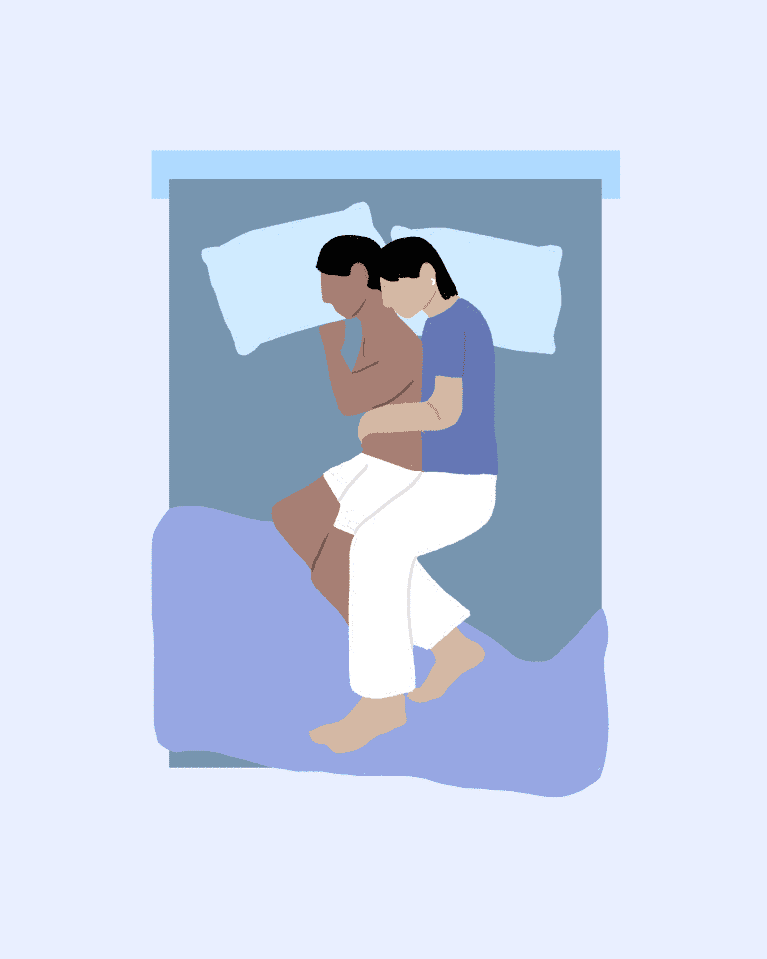
Jenny Chang-Rodriguez
The Loose Spoon
A variation on the traditional Spoon, the Loose Spoon just means there’s a bit of space between the couple. Don’t mistake those few inches for lack of intimacy, though. On the contrary, it usually means you’ve been together long enough to trust one another and don’t feel the need to constantly be touching. This position is the natural evolution of a couple who started their relationship in a tight Spoon but now recognizes quality sleep (and some space) is important
Jenny Chang-Rodriguez
The Chasing Spoon
Though this one may look like a standard Spoon, the Chasing Spoon is usually a little lopsided: One person has moved away from the center of the bed, and the other “chases” to physically reconnect. According to Sleep Positions: The Night Language of the Body, the Chasing Spoon could simply mean that one partner wants more space in the bed. The other, less literal interpretation is that the partner doing the drifting wants to be pursued
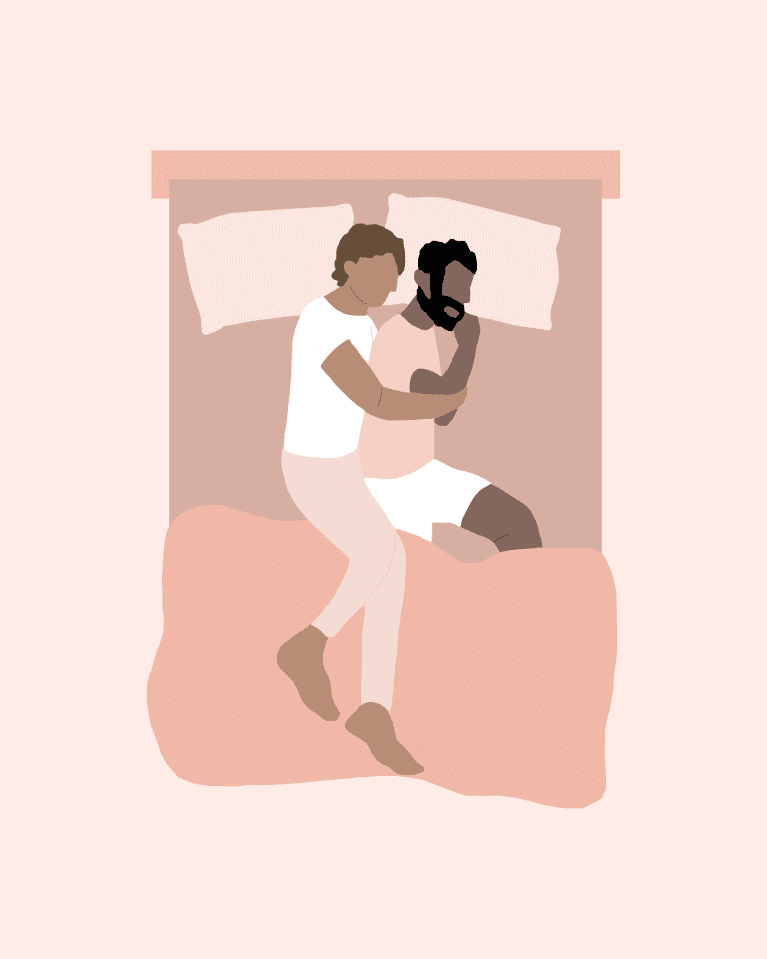
Jenny Chang-Rodriguez
The Unraveling Knot
Like the Loose Spoon, this position is typical of couples who’ve been together for some time. Though they start out touching (the Knot), they eventually “unravel” into independence. Sweet says it’s a “compromise between intimacy and independence, allowing for the best of both worlds,” though only about 8% of couples favor this position
Jenny Chang-Rodriguez
The Back Kissers
About 23% of couples fall asleep in this position, according to Sweet’s study. The Back Kissers fall asleep back-to-back, with contact along the spine. You’re connected but independent enough to appreciate your own space in bed. Because your butts still touch, you want to stay sexually connected despite your confidence to face in opposite directions. Chances are you’re a new couple who doesn’t yet have a reason for distrust or have been together for a while and are relaxed and comfortable with one another
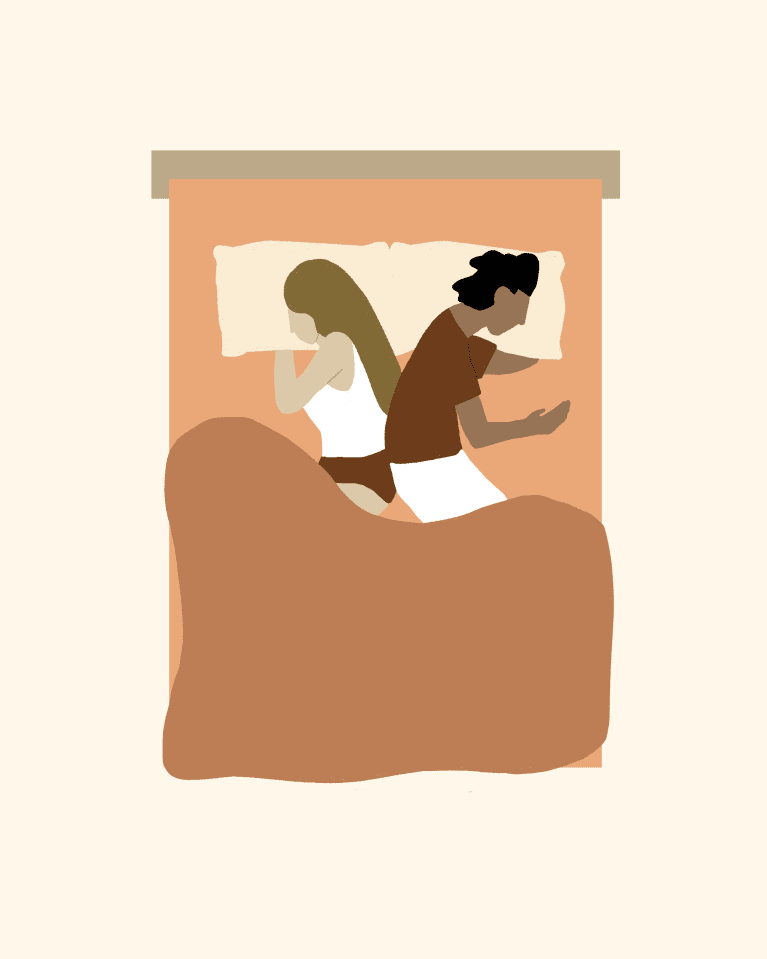
Jenny Chang-Rodriguez
The Liberty Lovers
Another position more common with established couples, the Liberty Lovers sleep back-to-back, but with space between them. Sweet’s study found 27% of couples fall sleep this way. Despite facing opposite directions and not touching, this position actually indicates you’re connected and secure. You can be close without touching, sharing a bed but independent. You’re the kind of couple that’s OK doing things alone but can’t wait to be back together to share stories and recount your day
Jenny Chang-Rodriguez
The Shingles
Not the sexiest name on the list but one that indicates a high level of comradeship. Typically, both partners are on their backs, with one resting his or her head on the other’s shoulder. Because of the strong egos here (people who sleep on their backs are thought to possess big personalities), when one partner complies and lets the other play protector, it means you really understand each other. It indicates confidence in the relationship
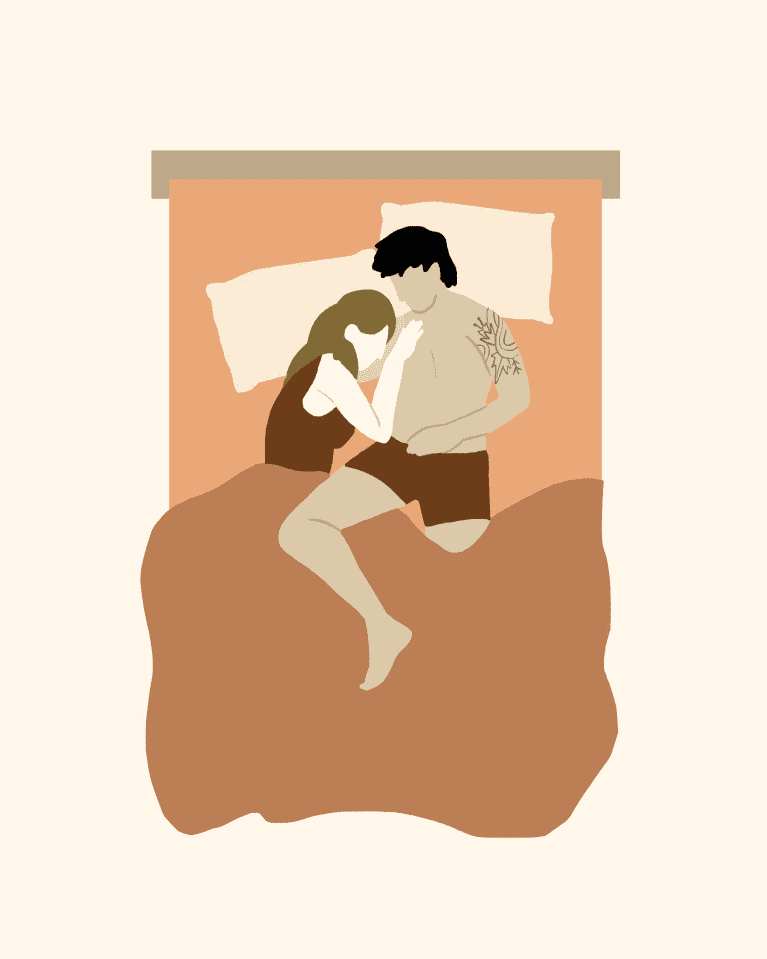
Jenny Chang-Rodriguez
The Nuzzle
The ultimate sign of trust and protection, the Nuzzle is common in new and rekindled relationships. When one partner sleeps with his or her head on the other’s chest, it creates a nurturing, open position and a sense of companionship as you snuggle
Sleeping on your back indicates confidence and self-assurance and sends the message that you’re using your power to protect your partner. If you’re the one resting on your partner, you’re independently dependent—capable of doing your own thing but appreciative of and in love with your significant other.
Jenny Chang-Rodriguez
The Tangle
Ah, young love! If you favor the Tangle, chances are you’re in a fairly new relationship and can’t bear to be separated for even a second. It’s an incredibly intimate position that means you can’t get enough of each other. If, however, you’re still sleeping like this after the six-month mark, it could mean you’re too dependent on each other. Just 2% of couples prefer this position

Jenny Chang-Rodriguez
The Leg Hug
The Leg Hug is a little unclear, as it can indicate a number of things. If only one person is doing the “hugging,” it could signal that they are craving a connection with the other (kind of like the Chasing Spoon). And since your legs are first to react in a fight-or-flight situation, they’re often the most honest part of the body
If you’re both intertwined, you’re equally passionate, and the emotional and sexual connection is strong. Just like your legs, your lives are blended and balanced
A third interpretation of the Leg Hug is that since the contact is so casual, it could imply you’re ambivalent about expressing affection or just had a fight but are trying to maintain a connection, despite heated emotions
Jenny Chang-Rodriguez
The Stomach Snoozers
A couple that sleeps on their stomachs might want to think about having a conversation. Because sleeping facedown protects the front of the body, the Stomach Snoozer position could be indicating signs of anxiety, emotional fear, vulnerability, or lack of control
It’s also not an intimate position—none of the body parts associated with sex are in play here—so it could also mean there’s a lack of sexual trust in the relationship
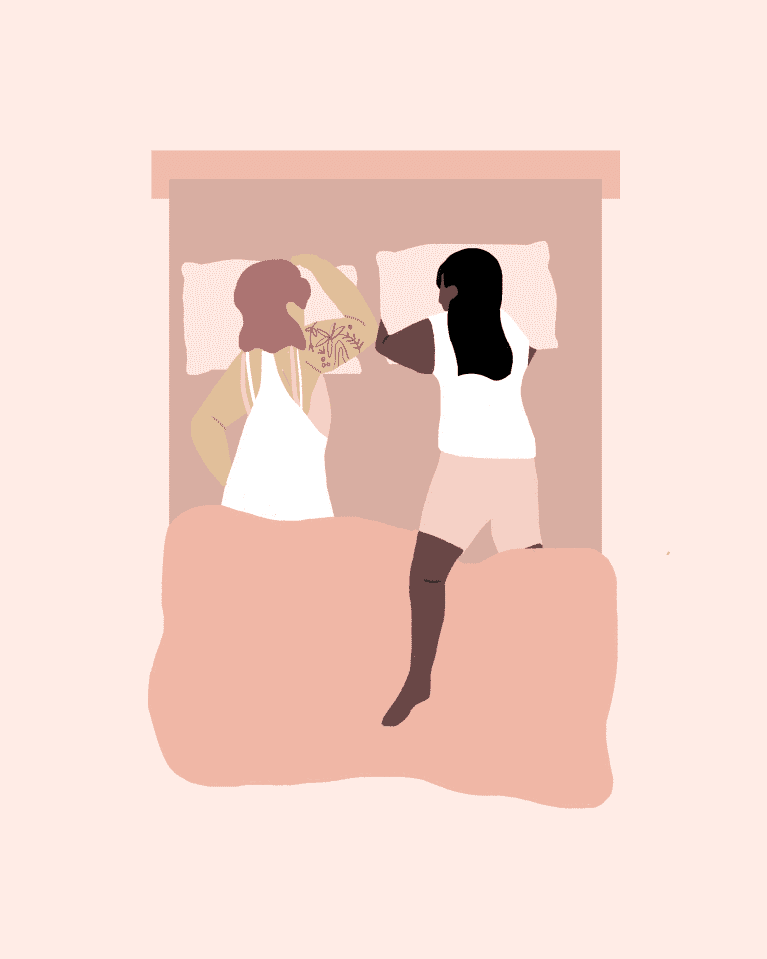
Jenny Chang-Rodriguez
The Space Hog
If your partner spreads out with little regard for where you are in the bed, it could be a negative sign for the relationship. The Space Hog—who, as the name indicates, spreads themselves out in bed, taking up all the space—is behaving selfishly and has little regard for your needs
If one partner dominates the bed, it’s likely they dominate the relationship, relegating their partner to a secondary, submissive role. If one partner’s head is higher (closer to the headboard) than the other’s, that could signal they’re more confident than their lower-sleeping partner. Conversely, if your heads are parallel, you are like-minded equals
Jenny Chang-Rodriguez
Remember these are just clues and interpretations, not diagnoses. If you’re worried about your relationship or the way you’re sharing the bed, just talk to your partner about it. If you’re happy with your relationship and fine with whatever position you doze off in, that’s all that matters
.The Start Of A New Relationship
The beginning of a relationship is full of butterflies. Though, as romantic as that all sounds, sometimes the fluttering isn’t a giddy reaction at all; instead, it’s an uneasiness that stems from something called early relationship anxiety, and it’s a phenomenon rooted in the anticipation of the unknown
“Relationship anxiety refers to the feelings one often associates with getting to know someone for the first time on a romantic level,” says licensed psychotherapist Siobhan D. Flowers. She goes on to say that It’s “an innate desire to be ‘liked’ and ‘accepted,'” she says, adding that it’s a “very common” anxiety.In This Articl
?What does early relationship anxiety look like
Oftentimes, Flowers says, individuals experiencing early relationship anxiety will measure their sense of self-worth based on whether someone reciprocates romantic interest in them—often expected in the form of constant communication throughout the day, usually via text or social media
Indeed, the signs that someone is experiencing early relationship anxiety are a little more apparent thanks to social media and smartphones connecting us to whomever, whenever. According to Sanam Hafeez, an NYC-based neuropsychologist and faculty member at Columbia University, neediness in the form of sending multiple texts, holding your breath until you get a response,
and then overanalyzing what they said is a telltale sign that you’re deep in the trenches of early relationship anxiety. “Checking their social media constantly to see who they recently friended on Facebook and what comments were made,” Hafeez says, is also a manifestation of this anxiety—one that never existed prior to 24/7 connectivity
Other ways this anxiety shows up in your actions? Asking about love, about moving in together, constantly bringing up a vacation or event months in advance to test their commitment—basically any subject matter having to do with the future can be a sign of early relationship anxiety. It’s a way of putting out feelers to verify how the other person feels about the relationship
Hafeez says things like resenting your partner for having a night out with their friends or for giving up a routine or something important to you like doing a spin class after work together is another way early relationship anxiety can show itself
?Where does early relationship anxiety come from
There are a few reasons anxieties might flare up at the start of a relationship, but it all boils down to a combination of circumstances and how you react to those circumstances. For example, let’s say you meet your S.O. at a bar or on a dating app; you don’t know what to expect because every single thing is new
In that instance, Jane Reardon, a relationship expert and founder of the RxBreakup app tells mbg it’s “quite normal to have some anxiety” because you don’t have a history with this person, and you don’t know if it will work out or if they feel the same way toward you. “Since there’s no track record, you can also feel unsure that the person is who they say they are,” she says
That being said, however, Reardon says how you respond to the unknown of what’s to come of your relationship is generally a reflection of one of three things
1. You’ve experienced relationship trauma in the past
When entering a new relationship, it’s normal for that little voice in the back of your mind to dredge up relationship baggage from the past out of fear that history will repeat itself
2. This relationship, in particular, makes you feel insecure for some reason
If it’s not past relationship issues wearing you down, it might be that there’s something about this relationship, in particular, that’s putting you on edge. Maybe you feel insecure around your S.O.’s friends or family, or maybe something about your partner’s behavior rubs you the wrong way or makes you feel unappreciated
3. You and your new partner’s attachment styles don’t add up
Attachment theory is rooted in the idea that your experiences with love from a young age (i.e., how your parents showed you affection, how you were shown love in past relationships, etc.) will ultimately determine how you love now. There are three types of attachment styles: secure attachment (in which a person is confident in their relationship and stays bonded), anxious attachment (where someone needs constant reassurance from their partner that everything is all good), and avoidant attachment (where you avoid intimacy at all costs).
“Ironically, people with anxious attachment styles usually partner up with people with avoidant attachment styles,” Reardon tells mbg, which, as you can imagine, might be a recipe for disaster. “As much as these styles match, they actually bring out the worst in each other,” Reardon says. “The anxious partner gets more anxious, the avoidant more avoidant, so in that sense, they are totally reacting to each other, and although they’re definitely bonding, it’s not in a healthy way
So, how do you work through early relationship anxiety
1. Ask yourself why you feel the way you do, instead of judging and criticizing your emotions
Latoya Nelson, a licensed professional counselor specializing in anxiety, tells mbg that the first step in overcoming these deep-rooted emotions and how they are affecting your behavior is to put them into perspective. To do this, try writing your feelings in a journal or talk to a therapist to help you “identify the source and process feelings regarding it
Does your anxiousness stem from negative experiences in past relationships? Or are they tied to something particular about this relationship and this person? If the former, acknowledging your fear of being hurt again can help you at least understand and accept your feelings of anxiety. If the latter, it’s worth considering whether the relationship you’re in is really giving you enough joy to outweigh the negativity
2. Be open with your partner about how you’re feeling
If you’re experiencing early relationship anxiety, your feelings are valid and are often trying to relay valuable information, Juicebox coach and sex educator Stella Harris tells mbg. “It can be helpful to tell your partner how you’re feeling,” she says. “For one, it’s helpful to set a precedent of honesty and transparency. Also, getting in the habit of asking for reassurances when you need them can be really helpful
If your partner responds poorly to your need for reassurance—or if you don’t feel comfortable asking for it from this person for whatever reason—then that’s another reason to think through whether the relationship you’re in is really the right one for you. After all, Clarissa Silva, behavioral scientist, relationship coach, and the creator of Your Happiness Hypothesis Method, tells mbg you want to find someone who complements you and who brings out the best in you.
However, before talking to your partner, Harris tells mbg it’s important to think about how much attention and affection you expect from the people in your life and be realistic with yourself about those expectations. “It’s really important to get your needs for connection met in a variety of places, such as from your friends and social network,” Harris says. “It’s not possible or healthy for one person to be your everything
3. Focus on the present moment and not the “what ifs” of the future
Sometimes when you enter into a new relationship, you might try protecting yourself from reliving past hurt by doubting yourself and doubting the intentions of your partner. Instead of trying to prevent history from repeating itself, Silva suggests empowering yourself by “experiencing the relationship from a strengths perspective
In other words, hone in on how this new bond enhances your life in the present moment. When you’re focused on everything you’re not getting from your new partner, it can be easy to get consumed by anxiety, longing, and frustration. But maintaining a practice of focusing on all the good stuff the new relationship is adding to your life can help dispel that negative energy and allow you to enjoy the ride—unknowns and all

